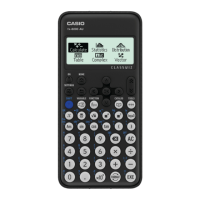Example 1: To verify whether 4√9 = 12 is true or false
4 9
– [Verify] > [=]*
12
* You can select the equality symbol or inequality symbol from the menu
that appears when you press and then select [Verify].
Example 2: To verify whether 0 <
(
8
9
)
2
-
8
9
is true or false
0 – [Verify] > [<]
8 9 8 9
Verifiable Expressions
You can input the following expressions for verification.
• Equalities or inequalities that include one relational operator
4 = √16, 4 ≠ 3, π > 3, 1 + 2 ≤ 5, (3 × 6) < (2 + 6) × 2, etc.
• Equalities or inequalities that include multiple relational operators
1 ≤ 1 < 1 + 1, 3 < π < 4, 2
2
= 2 + 2 = 4, 2 + 3 = 5 ≠ 2 + 5 = 8, etc.
Expression Input Precautions
• The following types of expressions cause a Syntax ERROR and cannot
be verified.
- An expression in which multiple relational operators that are not
oriented in the same direction (Example: 5 ≤ 6 ≥ 4)
- An expression that contains two of the following operators in any
combination (Example: 4 < 6 ≠ 8)
•
Certain expressions that do not correspond to those described above
may also produce a Syntax ERROR and cannot be verified.
Performing a Sequential Verification Operation on
the Right Side of an Expression
When the result of an equality or inequality true-false verification that
includes a relational operator is displayed, selecting a relational operator
from the CATALOG menu inputs the right side of the expression being
verified as the next line. This capability can be used to perform sequential
true-false verification of an equality or inequality.
Example: Perform continuous true-false judgment of (x + 1)(x + 5) = x
2
+ x
+ 5x + 5 and x
2
+ x + 5x + 5 = x
2
+ 6x + 5
61

